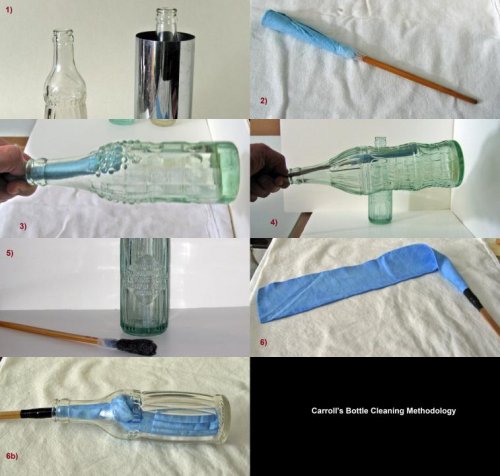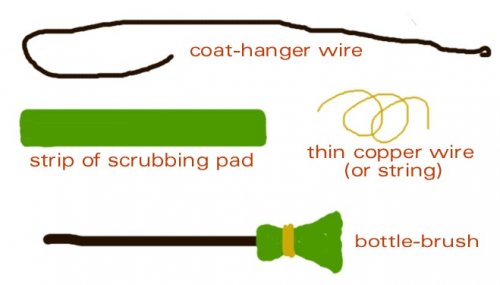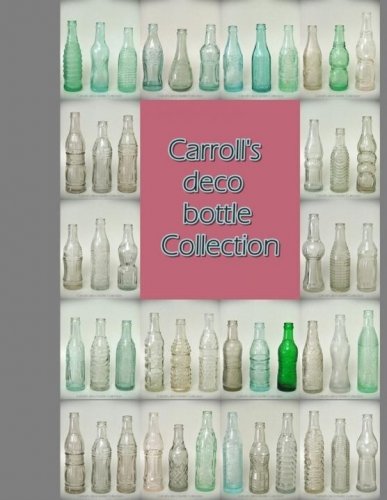Deco, shaped, fancy, specialty bottles can be difficult to clean. This is the method I've developed featuring the Veri-Clean gravity activated cleaning swab. I have had surprising success that far exceed any previous method I have tried (never done tumbling). Use lukewarm water from the tap for this process. DISCLAIMER: I DO NOT RECOMMEND THIS PROCESS FOR ACL BOTTLES.
1) Use a cylindrical container in which to set the soda bottle full of water, fill the container with water, then drop 1/2 denture tablet in the bottle and the other 1/2 in the container. Let sit 1 hour or overnight. This preps both the inside and outside of the bottle. I prefer the Original Efferdent formula. [old cocktail mixer shown.]
2) Prepare the Veri-Clean swab. Materials: 1/2 Scott Shop Towel (paper towel reinforced with latex); 1 large sturdy chopstick square at the handle (not a take-out freebee); Scotch Tape. Assemble to resemble the image. The shop towel goes around the 'handle' of the chopstick and is folded over 1/2 inch. The chopstick goes into the fold but since chopsticks are generally tapered it may help to taper the fold from 1/2 inch to 1 inch. Roll it up and tape it at the tail. Then make a second swab.
3) Empty and rinse the bottle, dampen then insert swab. Important operation instruction - grasp the chopstick at the neck of the bottle and let the weight of the bottle put pressure against the swab. That's the secret gravity activated cleaning action. Rotate the bottle slowly adjusting the chopstick in and out. The bottle can contain water or not as long as it and the swab are wet. You want to hold the base of the bottle with your other hand but don't relieve the pressure on the swab head. This is why a sturdy chopstick is essential.
4) Prepare the Jumbo Swab for larger bottles such as 28 oz. Take a 36" long 1/4" square poplar dowel, cut in half, and sand the ends a little (coarse then fine) to smooth them a bit (all four ends). Then attach the Scott Shop Towel as before.
5) Prepare the Super Swab for bottles with more stubborn stains (especially in the neck). Four ought ("0000") steel wool will polish glass when used dry and it does a great job. Be certain that you have the superfine grade as the others WILL scratch glass. Also check for any superficial dings that the fibers could catch onto. Minor chigger bites and case wear shouldn't be a problem. Unroll the steel wool pad and cut a piece about 2" wide and 2.5" tall, with the predominant grain of the steel fibers being vertical. Affix as usual ensuring that you are taping against the grain, otherwise the swab pad will immediately fall apart. Tape it tightly to the chopstick. This swab will last quite a while as long as it does not get damp. Press downward on the chopstick to apply pressure against the upper neck. You will want to rinse and dry the bottle again to remove any steel dust.
6) Prepare the Shammy Swab for shaped bottles using the other half of the poplar dowel. While cleaning with the 'Veri-Quck' swabs you may notice some areas that the swab cannot reach. Cut a strip of synthetic chamois 2.5" wide and tape it to the dowel as shown. Twist the slightly damp material into a long 'rope' shape and feed into the bottle. Push the stick all the way in and twist it until you wrap enough material to contact the wide diameter areas. To remove, push the stick in, fill halfway with water, and the swab will pull right out.
7) You can use a wet plastic 'brillo' pad (no brass or metal reinforcements) to scrub the exterior then followup with a damp long nap terry towel.
8) Rinse and tilt upside down to dry.
9) Use the clean dry swab to absorb any remaining moisture and polish out any water spots. Polish the outside with a flour sack towel. The steel wool is used inside and/or outside at this point on stubborn areas as needed. The swabs are all reusable, replace the swabbing material as needed.

1) Use a cylindrical container in which to set the soda bottle full of water, fill the container with water, then drop 1/2 denture tablet in the bottle and the other 1/2 in the container. Let sit 1 hour or overnight. This preps both the inside and outside of the bottle. I prefer the Original Efferdent formula. [old cocktail mixer shown.]
2) Prepare the Veri-Clean swab. Materials: 1/2 Scott Shop Towel (paper towel reinforced with latex); 1 large sturdy chopstick square at the handle (not a take-out freebee); Scotch Tape. Assemble to resemble the image. The shop towel goes around the 'handle' of the chopstick and is folded over 1/2 inch. The chopstick goes into the fold but since chopsticks are generally tapered it may help to taper the fold from 1/2 inch to 1 inch. Roll it up and tape it at the tail. Then make a second swab.
3) Empty and rinse the bottle, dampen then insert swab. Important operation instruction - grasp the chopstick at the neck of the bottle and let the weight of the bottle put pressure against the swab. That's the secret gravity activated cleaning action. Rotate the bottle slowly adjusting the chopstick in and out. The bottle can contain water or not as long as it and the swab are wet. You want to hold the base of the bottle with your other hand but don't relieve the pressure on the swab head. This is why a sturdy chopstick is essential.
4) Prepare the Jumbo Swab for larger bottles such as 28 oz. Take a 36" long 1/4" square poplar dowel, cut in half, and sand the ends a little (coarse then fine) to smooth them a bit (all four ends). Then attach the Scott Shop Towel as before.
5) Prepare the Super Swab for bottles with more stubborn stains (especially in the neck). Four ought ("0000") steel wool will polish glass when used dry and it does a great job. Be certain that you have the superfine grade as the others WILL scratch glass. Also check for any superficial dings that the fibers could catch onto. Minor chigger bites and case wear shouldn't be a problem. Unroll the steel wool pad and cut a piece about 2" wide and 2.5" tall, with the predominant grain of the steel fibers being vertical. Affix as usual ensuring that you are taping against the grain, otherwise the swab pad will immediately fall apart. Tape it tightly to the chopstick. This swab will last quite a while as long as it does not get damp. Press downward on the chopstick to apply pressure against the upper neck. You will want to rinse and dry the bottle again to remove any steel dust.
6) Prepare the Shammy Swab for shaped bottles using the other half of the poplar dowel. While cleaning with the 'Veri-Quck' swabs you may notice some areas that the swab cannot reach. Cut a strip of synthetic chamois 2.5" wide and tape it to the dowel as shown. Twist the slightly damp material into a long 'rope' shape and feed into the bottle. Push the stick all the way in and twist it until you wrap enough material to contact the wide diameter areas. To remove, push the stick in, fill halfway with water, and the swab will pull right out.
7) You can use a wet plastic 'brillo' pad (no brass or metal reinforcements) to scrub the exterior then followup with a damp long nap terry towel.
8) Rinse and tilt upside down to dry.
9) Use the clean dry swab to absorb any remaining moisture and polish out any water spots. Polish the outside with a flour sack towel. The steel wool is used inside and/or outside at this point on stubborn areas as needed. The swabs are all reusable, replace the swabbing material as needed.



